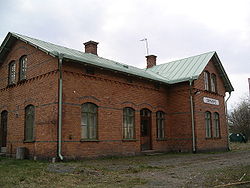Ormaryd – Anneberg railway line
| Ormaryd – Anneberg | |||||||||||||||||||||||||||||||||||||||||
|---|---|---|---|---|---|---|---|---|---|---|---|---|---|---|---|---|---|---|---|---|---|---|---|---|---|---|---|---|---|---|---|---|---|---|---|---|---|---|---|---|---|
|
Ormaryd railway station
| |||||||||||||||||||||||||||||||||||||||||
| Route number : | AOJ | ||||||||||||||||||||||||||||||||||||||||
| Route length: | 7 km | ||||||||||||||||||||||||||||||||||||||||
| Gauge : | 600 mm ( narrow gauge ) | ||||||||||||||||||||||||||||||||||||||||
| Top speed: | 20 km / h | ||||||||||||||||||||||||||||||||||||||||
|
|||||||||||||||||||||||||||||||||||||||||
The Ormaryd – Anneberg railway was a narrow-gauge railway in Sweden . It had a track width of 600 millimeters.
history
In 1867 August Kullberg founded the matchstick factory Annebergs Tändsticksfabrik in Anneberg . The wood came from the surrounding forests, chemicals and paper were transported by rail to Nässjö and then brought to the factory by cart on bad roads. On the way back, the wagons took finished goods with them. In May 1873 the railway between Eksjö and Nässjö and with it the Ormaryd station was opened.
From the summer of 1874 trains ran between Nässjö and Aneby . The Solberga station was set up there. Kullberg wanted to build a railway from his factory to this station , which was only four kilometers away , but the authorities did not approve it. The goods were transported by carts for another 30 years.
In 1903 CO Löwenadler became general manager of the match factory. On his initiative, the engineer C. Hult again made plans and maps for a railway line between Solberga and Anneberg. However, this new attempt did not lead to the hoped-for railway construction either.
The next step was to plan a route to Ormaryd train station, seven kilometers away. In the early summer of 1907, the route for a narrow-gauge railway Ormaryd - Muntarp - Anneberg with stops in Bokdungen and Muntarp Kärr was marked out. The line was inaugurated on March 23, 1909. A siding of the final stop, now called Småland Anneberg, led from the station to the match factory. On the route open to public transport, three pairs of trains ran daily to Ormaryd, which took around 20 minutes.
vehicles
For train operation, two steam locomotives were initially procured from the Hälsingborg – Triangeln – Råå / Ramlösa (HRRJ) railway company , which no longer needed them due to being changed to standard gauge. Another locomotive from Germany followed after the First World War . The first locomotives cost around 15,000 crowns . Two cars were bought for this purpose. One of these cars was 3rd class, the second also had a 3rd class compartment and a luggage compartment. The red-brown painted cars cost a total of 2,950 crowns. 28 wagons (open and covered) were available for freight transport .
| number | Surname | Wheel alignment | Manufacturer | Fabr.-No./ year of construction |
Special |
|---|---|---|---|---|---|
| 1 | C 1 t | Decauville Ainé (France) | 278 1899 |
1907 from Hälsingborg – Triangeln – Råå / Ramlösa (HRRJ) , there No. 4, + 1937 | |
| 2 | HELSINGBORG | B 'B t | Decauville Ainé (France) | 73 1889 |
1907 from Hälsingborg – Triangeln – Råå / Ramlösa (HRRJ), there No. 2, + 1923 |
| 3 | D t | Orenstein & Koppel , Berlin | 9129 1920 |
1934 to Stavsjö Järnväg , there no.2 , 1940 to Höganäs, there no.12 after conversion to 760 mm, + 1953 |
In 1910 the trains in Anneberg left at 6.45 a.m., 10.20 a.m. and 3.00 p.m., the return journeys from Ormaryd took place at 08.07, 12.22 p.m. and 4.52 p.m. A single journey cost 35 ore, children under 12 paid half the fare and children under three traveled for free.
In the 1930s, the railway company procured a motor draisine . This means that two pairs of trains with freight, mail and passengers were driven every day.
attitude
From 1932 an economic crisis began, as a result of which the owner of the company, Ivar Kreuger , known as the match king (Tändstickskungen) , committed suicide on March 12, 1932, presumably because of high debts. This also means the end of the match factory. In the summer of 1934 around 200 workers were laid off, the remaining 100 finished their work at Christmas 1934. Since the railroad no longer had to transport goods, the company ceased operations on January 1, 1935. The motorized trolley was used to transport mail until September 30, 1935. In 1936 the line was dismantled. The two cars came to Munkedals Järnväg . Many vehicles are preserved at the museum railway Östra Södermanlands Järnväg in Mariefred .
literature
- Willy Gustafsson, Lennart Welander: Anneberg-Ormaryds järnväg . Ed .: Östra Södermanlands Järnväg Museiföreningen. Eksjö 1977.
Web links
- Järnväg eller canal? Anneberg – Ormaryds Järnväg. In: solbergahembygd.se. Retrieved May 6, 2020 (Swedish).
- Anneberg - Ormaryds Järnväg (AOJ). In: oslj.nu. Retrieved May 6, 2020 (Swedish).
Individual evidence
- ^ Anneberg – Ormaryd. Bandel 479. In: banvakt.se. Retrieved May 6, 2020 (Swedish).
- ↑ Järnvägar i historien. 1909. In: historiskt.nu. Retrieved May 6, 2020 .
- ^ Anneberg - Ormaryds Järnväg (AOJ). In: pospichal.net. Retrieved May 6, 2020 .
- ↑ Järnvägar i historien. 1935. In: historiskt.nu. Retrieved May 6, 2020 .
